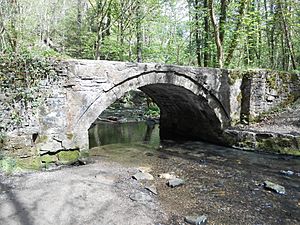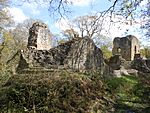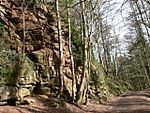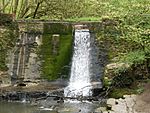Wepre Park facts for kids
Quick facts for kids Wepre Park |
|
|---|---|

Photo of Pont Aber
|
|
| Type | Public park |
| Location | Deeside, Wales |
| Operated by | Flintshire County Council |
| Visitors | 200,000 |
| Status | Open all year |
| Website | Wepre Park |
Wepre Park (Welsh: Parc Gwepra) is a large country park in Flintshire, Wales. It covers about 160 acres, which is like 120 football fields! This park is a fantastic place for outdoor fun near Connah's Quay.
Wepre Park is home to the historic Ewloe Castle. You can also find a children's playground, an outdoor gym, and football pitches here. There's also a visitor centre where you can learn more about the park.
Contents
What's in a Name?
The name "Wepre" might come from old Welsh words. It's thought to mean 'Water Hill'. The name has changed many times over the last 800 years.
A Look Back in Time
Wepre Park has a long and interesting history. The woods and estate were first mentioned in the Domesday Book. This was a big survey of England completed in 1086. Back then, the land belonged to St. Werburgh's Abbey in Chester.
Later, a family called the Fitz-Roberts owned the estate. During the English Civil War, a royalist commander used Wepre Hall. This was a large house on the estate.
In 1776, a man named Edward Jones bought the estate. He owned lead mines and rebuilt Wepre Hall in a grand Georgian style. After he passed away, his son sold off parts of the land. In 1830, a corn mill called Wepre Mill was built. It used a huge water wheel to grind grain.
After World War I, the estate was divided and sold. The farms became modern housing estates after World War II. During World War II, the British Army used Wepre Hall. From the 1950s, it became a home for older people.
In 1960, the local council bought the rest of the Wepre Hall estate. The old house was taken down. Today, you can still find the original cellars of the hall under the Wepre Park Visitors Centre.
Fun Things to Do
Wepre Park has many great things for visitors to enjoy.
- Visitor Centre: Get information and learn about the park.
- Playground: A large area for children to play.
- Outdoor Gym: Exercise in the fresh air.
- Football Pitches: Space for sports and games.
- Fishing Ponds: Enjoy a quiet time fishing.
- Woodland Walks: Explore beautiful trails through the trees.
- Nature Trails: Discover the plants and animals of the park.
- Toilets: Facilities for visitors.
- Recreation Area: Open spaces for relaxing.
- Free Parking: Easy access for cars.
Parkrun Fun
Every Saturday morning, a special event called a parkrun takes place here. It's a 5 km (about 3 miles) run or walk. The course is quite hilly and goes past the waterfall and Rosie Pool. It finishes near the visitor centre. It's a great way to stay active!
Amazing Wildlife
Wepre Park is a very important place for nature. It's protected as part of the Connahs Quay Ponds and Woodlands Site of Special Scientific Interest. This means it's home to rare animals and plants. For example, you might find the Great crested newt and badgers here. Both of these animals are protected by law.
Famous Places to See
Ewloe Castle
Ewloe Castle (Welsh: Castell Ewlo) is an old Welsh castle near Ewloe. It was one of the last castles built by the Welsh Princes. The castle was left unfinished when Edward I invaded Wales in 1277.
The castle was built using local sandstone. It stands on high ground near the Chester road. This gave it a great view of the Wales–England border. The castle is on a steep hill in a forest valley. It looks over where two streams meet.
You can walk to the castle from the visitor centre. It's about 1 kilometer (half a mile) away. It's free to enter and explore! Ewloe Castle is special because it has a D-shaped tower called 'The Welsh Tower'. CADW looks after this historic site.
Red Rocks
The "Red Rocks" are a striking feature of the park. You can see them easily, and much of Ewloe Castle was built from this same stone. The rocks are red because of the iron in the sandstone. Long ago, when Wales was a warm, wet, tropical place, the iron in the sand rusted.
Red rocks often mean that coal is nearby. Wepre Park has many small pits where people used to dig for coal by hand. This was before big machines were invented during the Industrial Revolution.
Woodland Walk
The park has a lovely trail that follows Wepre brook. Along the way, you'll pass Pont Aber and a beautiful waterfall.
Waterfall
The park's waterfall wasn't just for show! It was originally built to power a small hydroelectric plant. This plant made electricity for Wepre Hall.




